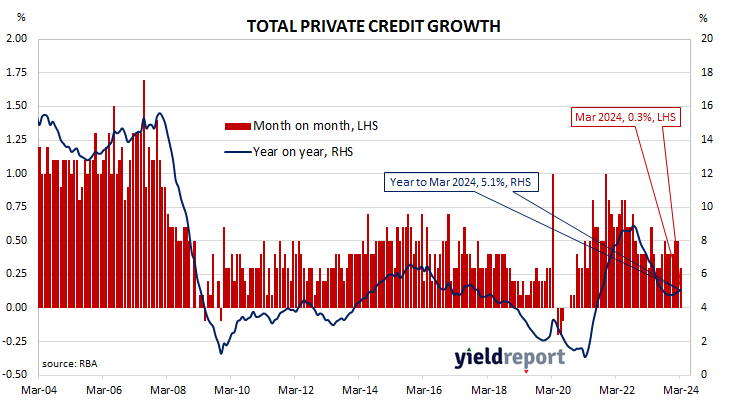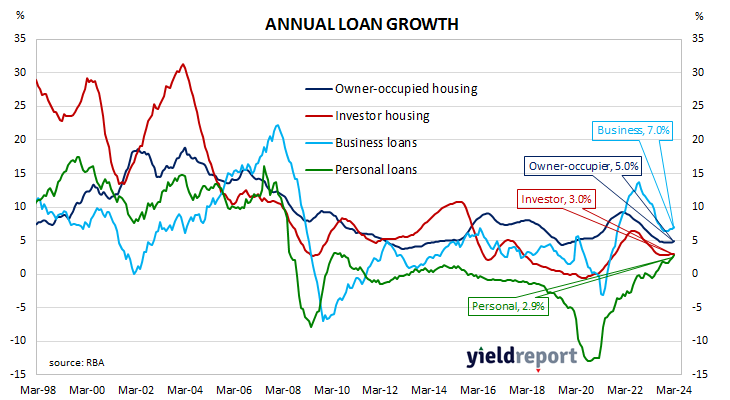Private sector credit up 0.3% in March, less than expected; annual growth rate ticks up to 5.1%; Westpac: modest growth in environment of elevated interest rates, sluggish economy operating at high capacity; ACGB yields fall; rate-change expectations somewhat mixed; business segment accounts for 50% of net growth.
The pace of lending growth in the non-bank private sector by financial institutions in Australia followed a steady-but-gradual downtrend from late 2015 through to early 2020 before hitting what appears to be a nadir in March 2021. That downtrend ended later in that same year and annual growth rates shot up through 2022, peaking in September/October before easing through 2023.
According to the latest RBA figures, private sector credit increased by 0.3% in March. The result was less than the 0.4% increase which had been generally expected as well as February’s 0.5% rise. On an annual basis, the growth rate ticked up from February’s figure of 5.0% to 5.1%.
“This modest growth occurred in an environment of elevated interest rates and a sluggish economy but also an economy operating at a high level of capacity, with unemployment still near historic lows and a housing market where demand is outstripping limited supply,” said Westpac senior economist Matthew Hassan.
Commonwealth Government bond yields fell almost uniformly across the curve, outpacing the falls of US Treasury yields on Monday night. By the close of business, the 3-year ACGB yield had lost 7bps to 4.03%, the 10-year yield had shed 6bps to 4.44% while the 20-year yield finished 7bps lower at 4.70%.
In the cash futures market, expectations regarding rate changes later this year or in 2025 were somewhat mixed. At the end of the day, contracts implied the cash rate would remain close to the current rate for the next few months and average 4.33% through May and 4.35% in June. However, November contracts implied a 4.40% average cash rate, February contracts implied 4.31%, while May 2025 contracts implied 4.22%, 10bps less than the current rate.
Business lending each accounted for just under 50% of the net growth over the month while owner-occupier lending accounted for around 25%. Investor lending accounted for around 10% while personal lending accounted for the balance.
The traditional driver of overall loan growth, the owner-occupier segment, grew by 0.4% over the month, in line with the previous seven months. The sector’s 12-month growth rate increased from 4.8% to 5.0%.
Total lending in the non-financial business sector increased by 0.5%, down from 0.6% in February after revisions. Growth on an annual basis picked up from 6.8% to 7.0%.
Monthly growth in the investor-lending segment slowed to a near-halt in early 2018 and essentially stayed that way until mid-2021. In March, net lending rose by 0.3%, up from 0.2% in February, maintaining the 12-month growth rate at 3.0%.
Total personal loans increased by 0.3%, in line with February’s growth rate, while the annual growth rate increased from 2.4% to 2.9%. This category of debt includes fixed-term loans for large personal expenditures, credit cards and other revolving credit facilities.



